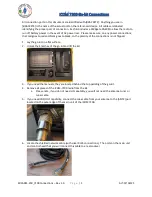
195
BARRETT 4050 HF SDR TRANSCEIVER - OPERATING AND INSTALLATION MANUAL
Note: If the wander lead is damaged or lost and requires replacing, the number on
WKHÀUVWWDSLQGLFDWHVWKHOHQJWKRIWKHUHSODFHPHQWZDQGHUOHDGUHTXLUHG
Example: Wl-60 indicates the length of the wander lead was 60cm. When
making a replacement wander lead ensure it is made to this length to obtain
optimum performance.
Operation Instructions
The 914 manual tapped whip antenna should now be screwed into the base
and spring mounted on the front of the vehicle.
The operation frequency being used on the Transceiver should now be selected
on the antenna. This is accomplished with the supplied jumper lead as indi-
cated in the diagram below and the following example (Note: this is an exam-
ple only and your antenna will be manufactured with different frequency taps.)
The 914 manual tapped whip antenna used in the example has the following
frequencies:
Channel 1 4030 kHz
Channel 2
4760 kHz
The illustration shows a
10 frequency 914 manual
tapped whip antenna
with the highest
frequency being selected.
Channel 3 5190 kHz
Channel 4
5254 kHz
Channel 5 7180 kHz
Channel 6
8199 kHz
Channel 7 9134 kHz
Channel 8
9145 kHz
Channel 9 10567 kHz
Channel10 14567 kHz
When using Channel 1, frequency 4030 kHz, the
jumper lead should be removed from the bottom
antenna socket and stored in the vehicle.
On all other channels the jumper lead is required:
For Channel 2, frequency 4760 kHz, the jumper is
plugged into the bottom socket then wound tight-
ly around the antenna and the other end plugged
into the socket marked 4760.
For Channel 3, frequency 5190 kHz, the jumper is
plugged into the bottom socket then wound tight-
ly around the antenna and the other end plugged
into the socket marked 5190.
And so on, to Channel 10.
Summary of Contents for 4050 HF SDR
Page 218: ......
















































